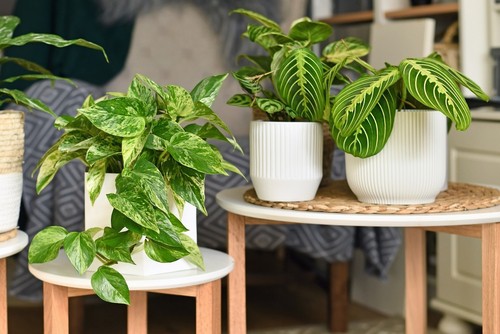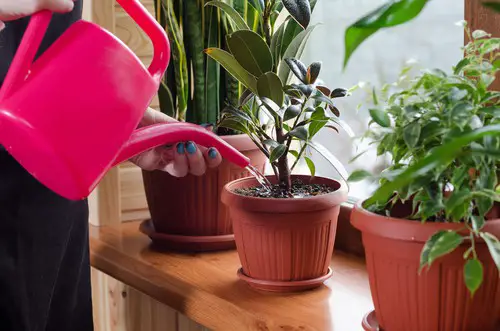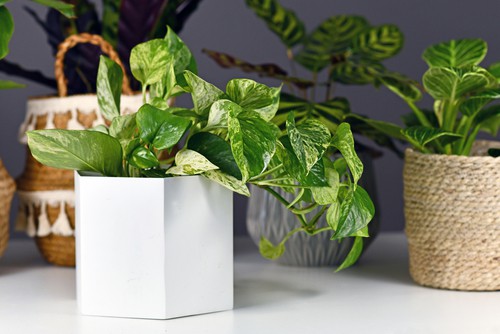Pothos and philodendron are two of the most popular houseplants that are known for their easy care and beautiful foliage. Many plant enthusiasts wonder if it is possible to plant these two together, and the answer is yes! In fact, planting pothos and philodendrons together can be beneficial for both plants.
Understanding the care requirements of pothos and philodendron is essential before planting them together. Both plants thrive in similar conditions, including bright, indirect light, moderate watering, and well-draining soil.
When planted together, it’s much easier to care for them as they have similar care requirements. Additionally, planting them together can create a beautiful and lush display of foliage in your home.
Key Takeaways on How to Plant Pothos and Philodendron Together
- Pothos and philodendron can be planted together as they have similar care requirements.
- Both plants thrive in bright, indirect light, moderate watering, and well-draining soil.
- Planting pothos and philodendron together can create a beautiful and easy-to-care-for display of foliage in your home.
Also don’t miss:
- Can You Plant Pothos and Monstera Together?
- Can You Plant Peppers Deep Like Tomatoes?
- Can You Plant Lettuce and Collards Together?
Understanding Pothos and Philodendron
Pothos and philodendron are two popular houseplants that can be grown together. They are both tropical houseplants that are easy to care for and can thrive in similar conditions. Both plants are known for their attractive foliage and are often grown for their vines, which can be trained to climb up walls or trellises.
Pothos

Pothos, also known as Epipremnum aureum, is a popular houseplant that is native to the Solomon Islands. It is a member of the Araceae family and is related to other popular houseplants such as the peace lily and the ZZ plant.
Pothos is known for its heart-shaped leaves and its ability to grow in low light conditions. It is also a very forgiving plant and can tolerate a wide range of temperatures and humidity levels.
There are several varieties of pothos, including the golden pothos, which has green and yellow leaves, and the marble queen pothos, which has green and white variegated leaves. Pothos is also known for its air-purifying properties and can help remove harmful toxins from the air.
Philodendron
Philodendron is another popular houseplant that is native to the tropical regions of Central and South America. It is a member of the Araceae family and is related to other popular houseplants such as the monstera and the anthurium.
Philodendron is known for its dark green leaves and its ability to grow in low light conditions. It is also a very forgiving plant and can tolerate a wide range of temperatures and humidity levels.
There are several varieties of philodendron, including the heartleaf philodendron, which has heart-shaped leaves, and the split-leaf philodendron, which has large, deeply lobed leaves. Philodendron is also known for its air-purifying properties and can help remove harmful toxins from the air.
Planting Pothos and Philodendron Together
When planting pothos and philodendrons together, it is important to consider their basic needs. These two plants are known for their easy care, but there are still some important factors to keep in mind for successful growth.
1. Soil and Potting Mix
Both pothos and philodendrons prefer well-draining soil that is rich in organic matter. A good potting mix should contain a mixture of peat moss, perlite, and vermiculite. This will provide the necessary nutrients and drainage for healthy growth. It is also important to ensure that the potting mix is not too heavy, as this can lead to waterlogged soil and root rot.
2. Light
Pothos and philodendrons both thrive in bright, indirect light. Direct sunlight can scorch their leaves and cause damage. It is best to place them near a window with filtered light or in a shaded area with bright, indirect light.
3. Watering

Both pothos and philodendrons have similar watering requirements. They prefer to be kept moist but not waterlogged. Overwatering can lead to root rot and other issues. It is important to allow the soil to dry out slightly between waterings. A good rule of thumb is to water when the top inch of soil feels dry to the touch.
4. Growing Container and Drainage Holes
When planting pothos and philodendrons together, it is important to choose a container with adequate drainage holes. This will help prevent water from accumulating in the bottom of the container, which can lead to root rot. It is also important to choose a container that is large enough to accommodate both plants.
5. Temperature and Humidity
Pothos and philodendrons prefer warm, humid conditions. They thrive in temperatures between 65-80°F (18-27°C) and humidity levels of 40-60%. It is important to avoid placing them near drafty windows or air conditioning units, as this can cause stress and damage to the plants.
6. Pruning and Feeding
Regular pruning and feeding can help keep pothos and philodendrons healthy and thriving. It is important to remove any dead or damaged leaves and stems to promote new growth. Feeding with a balanced fertilizer every 4-6 weeks can also help provide the necessary nutrients for healthy growth.
Ideal Conditions for Growth
Pothos and philodendron are both tropical plants that thrive in similar conditions. When planted together, they can create a beautiful and lush display. However, it’s important to ensure that the plants have the right growing conditions to thrive.
1. Light
Both pothos and philodendron prefer bright, indirect light. They can tolerate lower light conditions, but they may not grow as quickly or produce as many leaves. Direct sunlight can scorch the leaves, so it’s best to keep them out of direct sunlight.
2. Humidity
Pothos and philodendron both prefer high humidity. They can tolerate lower humidity levels, but they may not grow as well. To increase humidity, you can use a humidifier or place a tray of water near the plants. Misting the leaves can also help increase humidity.
3. Soil

Pothos and philodendron prefer moist soil. They can tolerate slightly dry soil, but they may not grow as well. It’s important to ensure that the soil is well-draining to prevent root rot.
4. Temperature
Pothos and philodendron prefer warm temperatures between 65 and 85 degrees Fahrenheit. They can tolerate lower temperatures, but they may not grow as quickly. Avoid placing them near cold drafts or air conditioning vents.
Companion Planting
Companion planting is an age-old gardening trick that benefits both the gardener and the plants. When plants cohabit, they actually grow stronger and healthier. In addition to improving your home’s aesthetic, companion planting can make your job as a caregiver much easier.
When it comes to grouping plants, pothos and philodendrons are two plants that can be planted together. These two plants have similar care requirements, including the amount of water, type of light, and temperature. They also have similar trailing-vining growth patterns, which makes them a great houseplant combination.
Technically, any philodendron that follows the same trailing-vining growth pattern of pothos plant varieties can be combined. For example, the Golden Pothos can be combined with the Heartleaf Philodendron, and the Philodendron Brasil can be combined with the Neon Pothos.
When combined, asparagus ferns and pothos plants create an eye-catching contrast between the bright, feathery fronds of the former and the deep, thick green foliage of the latter, making them an instant focal point in any room.
Care and Maintenance
When it comes to caring for pothos and philodendrons planted together, there are a few things to keep in mind. These plants are generally low-maintenance, making them perfect for beginner gardeners or those who don’t have a lot of time to devote to plant care.
1. Care Requirements
Both pothos and philodendrons prefer indirect light and moderate watering. They also thrive in warm temperatures with high humidity, which makes them ideal for growing together since they have similar growing requirements. These plants are not picky about soil, so regular well-draining potting soil is suitable for both.
2. Growing Requirements
Planting pothos and philodendrons together can create a visually stunning display. Their lush foliage and similar appearance can complement each other, resulting in an attractive, cohesive look for your indoor garden or living space. The vibrant green leaves of both plants can add a fresh and inviting touch to any room.
3. Pruning

Both pothos and philodendrons benefit from regular pruning to keep them looking their best. Pruning also helps to promote healthy growth and prevent overcrowding. When pruning, be sure to use sharp, clean shears and cut back to just above a leaf node.
4. Low Maintenance
One of the great things about pothos and philodendrons is that they are low maintenance and can tolerate some neglect. If you forget to water them for a few days or even a week, they will likely bounce back with no harm done. However, it’s still important to keep an eye on them and make sure they are not completely dried out.
5. Negligence
While pothos and philodendrons are relatively low-maintenance, they still require some care and attention. Neglecting these plants can lead to issues such as yellowing leaves, root rot, and pest infestations.
Regularly check the soil moisture level and adjust watering as needed. Keep an eye out for any signs of pests or disease and take action promptly if necessary.
Common Houseplants for Companionship
When it comes to planting houseplants together, there are a variety of options available. Some houseplants thrive when planted together, while others can struggle in the same pot.
One popular option for companion planting is to pair pothos and philodendrons together. These two plants grow well when planted together and can actually make your job as their caregiver much easier.
Another great option for companion planting is to pair spider plants with a variety of other houseplants. Spider plants are one of the most popular houseplants out there and produce long thin foliage in a mix of green and white hues. They can be paired with succulents, ferns, and other trailing plants for a beautiful and diverse display.
Snake plants are another popular option for companion planting. These plants are known for their air-purifying properties and can be paired with a variety of other houseplants, including ferns, ivy, and philodendrons.
For those looking for a low-maintenance option, succulents are a great choice. These plants require minimal watering and can be paired with a variety of other plants, including spider plants, jade plants, and ponytail palms.
Other popular houseplants for companion planting include wandering jew, dracaena, begonia, and ficus benjamina. When paired together, these plants can create a stunning display of colors and textures.
Additional Tips for Healthy Plants

When planting pothos and philodendron together, there are a few additional tips that can help ensure healthy and thriving plants. These tips can be useful for any gardener, whether they are experienced or new to gardening.
Low-Maintenance Plants
One of the benefits of planting pothos and philodendron together is that they are both low-maintenance plants. They don’t require a lot of attention and can thrive in a variety of conditions. This makes them perfect for busy gardeners who don’t have a lot of time to devote to their plants.
Drought-Like Conditions
Both pothos and philodendron are plants that can tolerate drought-like conditions. This means that they don’t need to be watered as frequently as some other plants. However, it’s important to make sure that the soil doesn’t completely dry out, as this can be harmful to the plants.
Air Purifiers
Both pothos and philodendron are known for their ability to purify the air. They can remove toxins from the air, making them a great addition to any home. In fact, NASA has found that pothos is one of the best plants for removing formaldehyde from the air.
Leggy Plants
One issue that can arise when growing pothos and philodendron together is leggy plants. This is when the plants grow long and spindly, instead of being full and bushy. To prevent this, it’s important to make sure that the plants are getting enough light. If the plants are not getting enough light, they may need to be moved to a sunnier location.
Glossy Leaves
Both pothos and philodendron have glossy leaves, which can be attractive to pests. To prevent pests from infesting the plants, it’s important to keep the leaves clean and dust-free. This can be done by wiping the leaves with a damp cloth or spraying them with water.
Frequently Asked Questions
Can pothos and philodendron be planted together?
Yes, pothos and philodendron can be planted together. In fact, they are known to grow well together and can make caring for them easier.
What are some good companion plants for pothos and philodendron?
Some good companion plants for pothos and philodendron include spider plants, peace lilies, and ZZ plants. These plants have similar care requirements and can thrive in the same growing conditions.
Can I mix different varieties of philodendron when planting with pothos?
Yes, you can mix different varieties of philodendron when planting with pothos. However, it is important to ensure that the plants have similar care requirements to avoid any issues.
Which plants require similar care to pothos and philodendron for planting together?
Plants that require similar care to pothos and philodendron for planting together include spider plants, peace lilies, ZZ plants, and snake plants. These plants all prefer bright, indirect light and well-draining soil.
Is it okay to plant snake plant and pothos together?
Yes, it is okay to plant snake plant and pothos together. Both plants have similar care requirements and can thrive in the same growing conditions.
What are some common mistakes to avoid when planting pothos and philodendron together?
Some common mistakes to avoid when planting pothos and philodendron together include overwatering, using heavy soil that doesn’t drain well, and placing the plants in direct sunlight. It is important to ensure that the plants have similar care requirements and to monitor their growth regularly to avoid any issues.

Hey, I’m Lisa and I’ve been an avid gardener for over 30 years. I love writing, talking and living in the garden! Feel free to connect with me on my socials below


